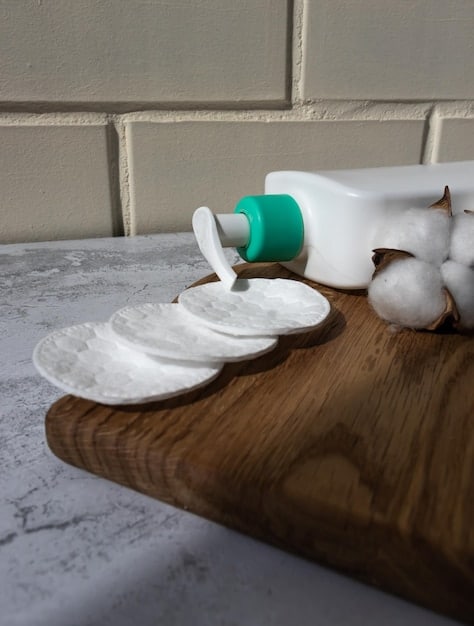The Ultimate 5-Step Nighttime Skincare Routine for 2025

The 5-Step Nighttime Skincare Routine Dermatologists Are Recommending in 2025 focuses on cleansing, treating, moisturizing, and protecting the skin, utilizing advanced ingredients and techniques to combat aging and environmental damage, ultimately promoting a healthier, more radiant complexion while you sleep.
Unlock radiant and youthful skin with the 5-Step Nighttime Skincare Routine Dermatologists Are Recommending in 2025. This guide provides a comprehensive yet straightforward approach to achieving optimal skin health while you sleep.
The Importance of a Nighttime Skincare Routine
Nighttime is when your skin repairs itself most effectively. Understanding why a dedicated routine is essential sets the stage for maximizing those restorative hours.
Your skin faces environmental stressors throughout the day, from UV rays to pollution. A nighttime skincare routine helps undo this damage.
Why Nighttime?
During sleep, blood flow increases, allowing your skin to absorb products more effectively.
- Cell turnover accelerates, making it an ideal time for active ingredients.
- The skin isn’t exposed to environmental stressors like sunlight and pollution.
- Nighttime routines can target specific concerns like wrinkles, acne, or dryness.
A well-crafted nighttime routine ensures you wake up with refreshed and revitalized skin.

By incorporating potent ingredients and consistent application, you prepare your skin for the next day and promote long-term health.
Step 1: Gentle Cleansing
Cleansing is the foundation of any effective skincare routine. It preps your skin and allows following products to penetrate efficiently.
Removing makeup, dirt, and oil is crucial for preventing clogged pores and breakouts.
Why Gentle Cleansing Matters
Harsh cleansers can strip your skin of its natural oils, leading to dryness and irritation.
- Opt for a mild, pH-balanced cleanser.
- Micellar water can be an excellent first step to remove makeup gently.
- Double cleansing (oil cleanser followed by a gentle cleanser) can be beneficial for removing all traces of impurities.
Gentle cleansing ensures your skin remains balanced and receptive to subsequent treatments.
Look for ingredients like ceramides and glycerin to maintain skin hydration while cleansing.
Step 2: Targeted Treatments and Serums
Serums rich in active ingredients address specific skin concerns, offering targeted solutions for your unique needs.
Popular ingredients include retinol, vitamin C, and hyaluronic acid.
Choosing the Right Serum
Retinol is fantastic for anti-aging, promoting collagen production and reducing fine lines.
Vitamin C is a powerful antioxidant that brightens the skin and protects against free radicals.
- Hyaluronic acid provides intense hydration, plumping the skin and reducing the appearance of wrinkles.
- Niacinamide can reduce inflammation and minimize pore size.
- Peptides help stimulate collagen and elastin production.
Consider your skin type and concerns when choosing a serum to maximize its benefits.
Apply serums after cleansing and before moisturizing to ensure optimal absorption.
Step 3: Hydration with Moisturizer
Moisturizing is a crucial step to hydrate and lock in moisture, keeping your skin supple and healthy.
Night creams are often richer and more emollient than daytime moisturizers.
Selecting the Best Night Cream
Look for ingredients like ceramides, hyaluronic acid, and shea butter for intense hydration.
Occlusives like petrolatum and dimethicone create a protective barrier to prevent moisture loss.
- For dry skin, opt for heavier creams with oils and butters.
- For oily skin, choose a lightweight, non-comedogenic formula.
- Consider creams with antioxidants for added protection and repair.

Applying moisturizer at night helps replenish the skin’s moisture barrier, preventing dryness and irritation.
Regular moisturization supports the skin’s elasticity and resilience.
Step 4: Eye Cream Application
The skin around your eyes is delicate and requires special care to combat fine lines, dark circles, and puffiness.
Eye creams are formulated with ingredients that specifically target these concerns.
Key Ingredients in Eye Creams
Peptides can help stimulate collagen production and reduce the appearance of wrinkles.
Caffeine can reduce puffiness and dark circles by constricting blood vessels.
- Hyaluronic acid provides hydration and plumps up fine lines.
- Retinol can improve skin texture and reduce wrinkles (use with caution due to potential irritation).
- Antioxidants protect the skin from free radical damage.
Gently apply eye cream with your ring finger to avoid tugging on the delicate skin around your eyes.
Use a light tapping motion to enhance absorption and minimize irritation.
Step 5: Optional Treatments and Masks
Adding occasional treatments like masks and peels can provide an extra boost to your skincare routine.
These treatments address specific concerns and enhance overall results.
Types of Nighttime Treatments
Overnight masks provide intense hydration and nourishment while you sleep.
Chemical peels can exfoliate the skin, revealing a brighter and smoother complexion (use with caution and follow instructions carefully).
- Spot treatments target breakouts and blemishes overnight.
- Sleeping packs offer a concentrated dose of active ingredients.
- Consider using a humidifier to add moisture to the air, further hydrating your skin.
Use these treatments 1-2 times per week to avoid over-exfoliation or irritation.
Always follow product instructions and monitor your skin for any adverse reactions.
| Key Step | Brief Description |
|---|---|
| 🧼 Gentle Cleansing | Removes impurities to prep your skin. |
| ✨ Targeted Treatments | Addresses specific skin concerns with serums. |
| 💧 Hydration | Locks in moisture and maintains skin’s suppleness. |
| 👁️ Eye Cream | Targets fine lines, dark circles, and puffiness. |
Frequently Asked Questions
▼
A nighttime skincare routine is crucial because your skin repairs itself most effectively while you sleep. It helps undo daytime damage and prepares your skin for the next day.
▼
The essential steps include gentle cleansing, applying targeted treatments and serums, hydrating with moisturizer, using eye cream, and optional treatments like masks or peels.
▼
Exfoliating 1-2 times per week is generally recommended to remove dead skin cells and promote a brighter complexion. Always monitor your skin for any signs of irritation.
▼
Look for hydrating ingredients like ceramides and hyaluronic acid, as well as occlusives like shea butter or petrolatum, to lock in moisture and keep your skin supple.
▼
While some products can be used both morning and night, others are better suited for specific times. For example, retinol is typically used at night due to its sensitivity to sunlight.
Conclusion
By following the 5-Step Nighttime Skincare Routine Dermatologists Are Recommending in 2025, you can significantly improve your skin’s health and appearance. Consistency and the right products will yield the best results, ensuring you wake up with a radiant and rejuvenated complexion every morning.





